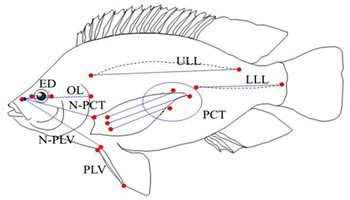VOLUME 7 NUMBER 2 (July to December 2014)

Philipp. Sci. Lett. 2014 7 (2) 420-427
available online: December 16, 2014
*Corresponding author
Email Address: rnmuallil@gmail.com
Submitted: July 26, 2014
Revised: October 16, 2014
Accepted: November 14, 2014
SHORT COMMUNICATION
Fluctuating asymmetry in genetically improved Nile Tilapia, Oreochromis niloticus (Linnaeus), strains in the Philippines
by Richard N. Muallil*1,2, Zubaida U. Basiao3, Tereso A. Abella4, and Luis Maria B. Garcia3
1Mindanao State University - Tawi-Tawi College of Technology and Oceanography, 7500 Bongao, Tawi-Tawi, Philippines
2Marine Science Institute, University of the Philippines Diliman, 1101 Quezon City, Philippines
3Institute of Biology, College of Science, University of the Philippines Diliman, 1101 Quezon City, Philippines
4Freshwater Aquaculture Center, Central Luzon State University, Nueva Ecija, Philippines
2Marine Science Institute, University of the Philippines Diliman, 1101 Quezon City, Philippines
3Institute of Biology, College of Science, University of the Philippines Diliman, 1101 Quezon City, Philippines
4Freshwater Aquaculture Center, Central Luzon State University, Nueva Ecija, Philippines
Fluctuating asymmetry (FA), a subtle random deviation between the left and right sides of symmetrically bilateral characters, is an easy and cost-effective tool for monitoring both genetic and environmental stressors that could undermine the overall health condition of an organism. In this study, we compared FA levels of thirteen bilateral characters in three common genetically improved Nile tilapia (GINT) strains in the Philippines, namely: GenoMar Supreme Tilapia (GenoMar), Genetically Improved Farmed Tilapia (GIFT), and Freshwater Aquaculture Center Selected Tilapia (FaST) strains. We found significantly higher FA levels in the GenoMar strain for opercular length and gill rakers. There was no significant difference in FA levels between the FaST and the GIFT strains for all the characters considered. Our findings indicate that the GenoMar strain may be experiencing higher stressors which are most likely due to the very high selection intensity done where only few and fast-growing individuals were included in the selection. Strong directional selection can result in loss of genetic variability, which is important in maintaining developmental stability. However, it is also possible that the stressors that might have caused higher FA levels in the GenoMar strain could be environmental in origin since the samples of the three GINT strains that we used in this study were reared in different environments. Thus, more studies are needed to elucidate further the relationships between FA levels and different stressors associated with the selection and rearing techniques used in GINT production. We also highly encourage further studies that will improve the effectiveness of FA as a tool for monitoring the levels of different stressors that may be undermining the long-term sustainability of GINT production in the country.
© 2024 SciEnggJ
Philippine-American Academy of Science and Engineering